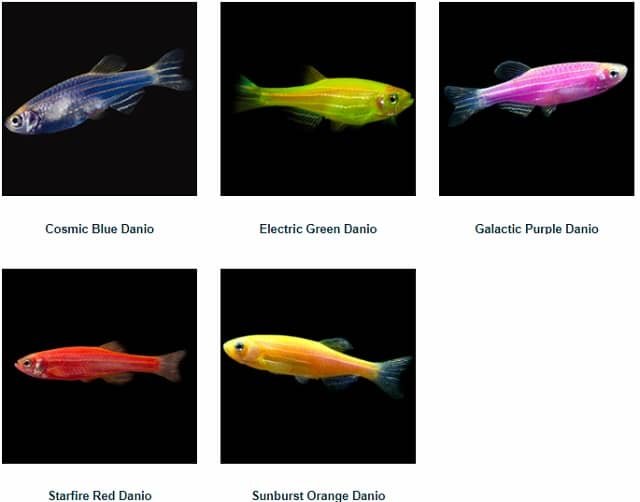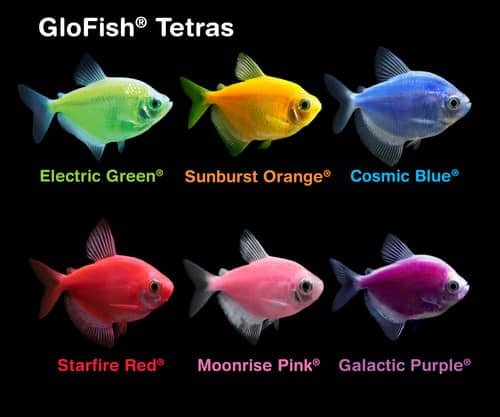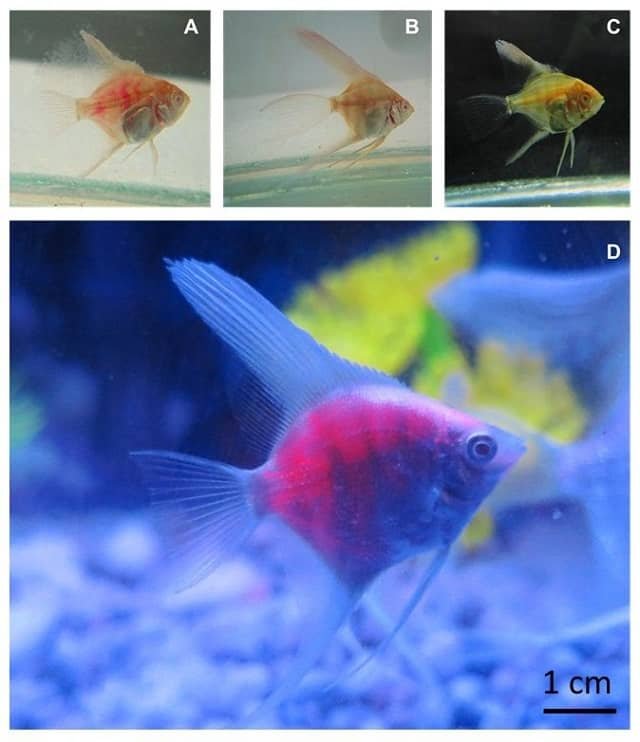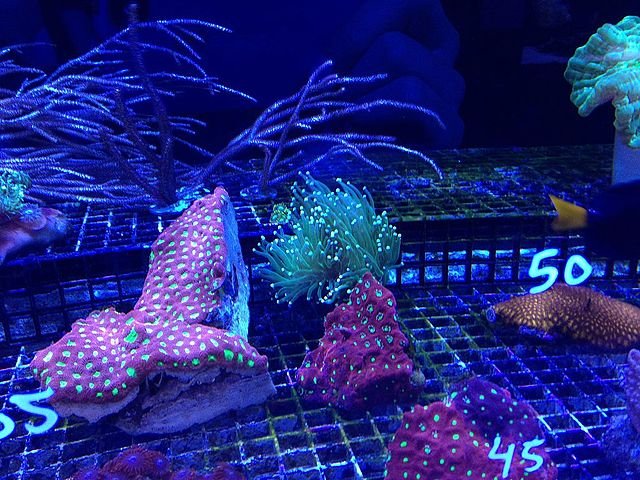
Fluorescent fish, also known as “glowing fish,” have become increasingly popular in home aquariums due to their unique and eye-catching appearance. These fish, which appear to glow under certain lighting, are the result of genetic modifications that incorporate fluorescent genes from jellyfish or corals. This trait, which enables them to emit light under special lighting, has made species like GloFish and glowing bettas favorites for those looking for a colorful and unique aquarium.
Currently, aquarium fish are in high demand, creating a market where many research centers and companies develop a variety of ornamental fish using genetics and transgenic approaches (Barman et al., 2019).
Originally, transgenic fish were developed for applications in human therapeutic production, experimental models for biological research, environmental monitoring, ornamental fish, and aquaculture production (Van Eenennaam & Olin, 2006).
The first fluorescent fish were developed in Singapore to investigate and monitor certain environmental toxins. Researchers from the National University of Singapore were the first to insert jellyfish fluorescent genes into zebrafish; they then realized the potential of transgenic fish for the ornamental industry.
Breeding fluorescent fish has become popular among aquarium hobbyists; however, it also enhances their decorative potential in aquariums (Aleksandrov, 2020), contributing to the growth of the ornamental aquatics sector by presenting new options. This article will thoroughly explore the different types of fluorescent fish, how to care for them, aquarium accessories that enhance their appearance, and the impact of these fish on the aquarium industry and science.
What Are Fluorescent or Phosphorescent Fish?
- 1 What Are Fluorescent or Phosphorescent Fish?
- 2 History of Fluorescent Transgenic Fish
- 3 What Differentiates Fluorescent Fish from Conventional Fish?
-
4
Types of Fluorescent Fish
- 4.1 Fluorescent Zebrafish (Danio rerio)
- 4.2 Transgenic Black Tetras or Monjita Fish (Gymnocorymbus ternetzi)
- 4.3 Fluorescent Tiger Barbs (Puntius tetrazona)
- 4.4 Fluorescent Rainbow Shark (Epalzeorhynchos frenatum)
- 4.5 Glowing betta fish (Betta splendens)
- 4.6 Fluorescent Marine Medaka (Oryzias dancena)
- 4.7 Fluorescent Angel Fish (Pterophyllum scalare)
- 4.8 Bright Koi and Carp Fish
- 5 Reproduction of Fluorescent Fish
- 6 Tanks for Transgenic Fluorescent Fish
- 7 Basic Care for Fluorescent Fish
- 8 Trade of Transgenic Fluorescent Fish
- 9 Compatibility
- 10 Risks of Fluorescent Fish
- 11 Frequently Asked Questions About Fluorescent Fish
- 12 Conclusion
- 13 References
- 14 Entradas relacionadas:
Fluorescent fish, also known as phosphorescent or glowing fish, are transgenic animals into which genes from bioluminescent marine organisms, such as jellyfish and sea anemones, have been introduced to produce fluorescent proteins. Illuminated with an aquarium ultraviolet lamp, these fish show their full fluorescence.
Often, the terms bioluminescent and fluorescent are used interchangeably, although they are not the same. Bioluminescence is a natural process in which some organisms produce light through internal chemical reactions, like certain fish inhabiting ocean depths. However, in the case of fluorescent fish, as explained above, fluorescence results from the insertion of genes from organisms such as jellyfish.
Transgenesis is applied to aquarium fish species to produce transgenic fish in various colors (Cebeci et al., 2020). In this regard, there are four main types of fluorescence that researchers have employed in ornamental fish:
Stay Always Informed
Join our communities to instantly receive the most important news, reports, and analysis from the aquaculture industry.
- Green fluorescence, which produces green-colored fish, is due to the GFP transgene (Green Fluorescent Protein) extracted from the deep-sea jellyfish Aequorea victoria.
- Red fluorescence, which produces pink fish, is due to the RFP transgene (Red Fluorescent Protein) extracted from coral (Discosoma sp.) and the sea anemone (Entacmea quadricolor).
- Yellow fluorescence, which creates an orange hue, is due to the YPF transgene (Yellow Fluorescent Protein).
- Cyan fluorescence, due to the CFP transgene (Cyan Fluorescent Protein).
Each fluorescent protein (green, red, cyan, or yellow) has its own structural characteristics, often including modifications from its wild-type progenitor (Thanh et al., 2014).
It is noteworthy that biofluorescence is also common in fish; Sparks et al (2014) reported more than 180 biofluorescent fish species, indicating that fluorescence is common and morphologically variable among coral reef fish lineages.

History of Fluorescent Transgenic Fish
Although the first transgenic fish emerged in the 1980s, it wasn’t until 1995 that the first transgenic zebrafish (Danio rerio) with green fluorescent protein was reported (Gong et al., 2001).
GloFish, the first commercial fluorescent fish, were developed to help researchers monitor river pollution. In 2003, Yorktown Technology began marketing fluorescent red transgenic zebrafish under the “GloFish” brand in the United States after obtaining a license from the National University of Singapore. If you want to learn more about GloFish, you can check out the interview with the lead scientist.
The first fluorescent zebrafish (Danio rerio) were produced by inserting fluorescent protein transgenes into the muscle tissue of the fish (Scotto y Serna, 2013).
Today, fluorescent protein transgenesis is used in the ornamental fish trade to produce new color morphs in tropical fish (Leggatt & Devlin, 2020). Currently, in addition to fluorescent zebrafish, GloFish has expanded its “products” to include tetras (black skirt tetras), tiger barbs, and rainbow sharks in various fluorescent colors.
What Differentiates Fluorescent Fish from Conventional Fish?
Fluorescent fish offer a unique visual experience, but there are some differences and considerations compared to conventional fish:
- Appearance: Fluorescent fish exhibit a unique glow under specific LED lights. Conventional fish do not offer the same visual effect in decorated aquariums.
- Compatibility in the aquarium: Although they can coexist with many common species, some fluorescent fish are more active and may stress other, less dynamic species.
- Additional care: While their needs are similar to those of other aquarium fish, they require an investment in special lights and decorations to maximize their fluorescent appearance.
Types of Fluorescent Fish
Fluorescent Zebrafish (Danio rerio)
Fluorescent zebrafish, or glowing zebrafish, were the first transgenic fish developed for health research and ecotoxicology; however, scientists also recognized their potential for the aquarium industry. Today, fluorescent zebrafish are sold in various presentations based on their coloration.
The GloFish company markets zebrafish in electric blue, green, purple, pink, red, and orange colors.

Recently, Ossa-Hernández et al., (2023) highlighted the potential of using red fluorescent protein, encoded by the DsRed gene, derived from the coral Discosoma sp. to enhance the color of zebrafish (Danio rerio).
Transgenic Black Tetras or Monjita Fish (Gymnocorymbus ternetzi)
Pan et al (2008) developed red fluorescent tetras, or widow fish (Gymnocorymbus ternetzi).
Genetically modified fluorescent tetras possess two transgenes that give them a phosphorescent green coloration under white, ultraviolet, or blue light (DFO, 2018).
Leggatt and Devlin (2020) examined the competitive foraging ability and cold tolerance of green transgenic tetras (Gymnocorymbus ternetzi). They reported that transgenesis did not affect the foraging success or aggressive behavior of adult or juvenile fish.
The company GloFish markets fluorescent tetras in electric blue, green, purple, pink, red, and orange colors.

Fluorescent Tiger Barbs (Puntius tetrazona)
The company GloFish markets fluorescent tiger barbs in electric blue, green, purple, pink, red, and orange colors.

Fluorescent Rainbow Shark (Epalzeorhynchos frenatum)
Rainbow sharks (Epalzeorhynchos frenatum), also known as green labeo, are freshwater cyprinids native to Southeast Asia.
The rainbow shark can reach a length of 16 cm. Its body is dark gray with bluish tones, and it features bright red fins.
The company GloFish markets rainbow sharks in electric blue, green, purple, pink, red, and orange colors.

Glowing betta fish (Betta splendens)
Glowing bettas are another popular option. These territorial fish, available in a wide variety of colors, find an additional appeal in their fluorescence. They are ideal for small tanks and require decorations that help them feel comfortable in their environment. GloFish markets male and female bettas in electric green.

Fluorescent Marine Medaka (Oryzias dancena)
The fluorescent marine medaka (Oryzias dancena) was established through the transgenesis of a cyan fluorescent protein gene (Thanh et al., 2014). As an euryhaline species, it can grow very well in both freshwater and marine aquariums.
Fluorescent Angel Fish (Pterophyllum scalare)
Although fluorescent angel fish are being marketed, the techniques employed are not known. The company Jy Lin Trading announced the development of fluorescent green angelfish.
Meanwhile, Thanh et al (2022) report the transgenesis of angelfish with red fluorescent protein.

Bright Koi and Carp Fish
Bright koi and carp fish offer an alternative for those seeking large fluorescent fish. Although they are more difficult to find and care for in home aquariums, their presence is impressive.
Reproduction of Fluorescent Fish
In theory, fluorescent transgenic fish do not have the ability to reproduce; however, experiments such as those by Scotto and Chuan (2018) have demonstrated that the reproduction of fluorescent zebrafish from the early TK1 genetic lines is possible.
Additionally, Barroso et al (2022) report the reproduction of transgenic zebrafish in the natural environment of the Brazilian Amazon basin.
On the other hand, Howard et al (2015) conducted an experiment to determine the sexual selection mechanisms of transgenic zebrafish and wild zebrafish. They reported that wild-type males were significantly more aggressive than transgenic males when it came to reproduction.
Tanks for Transgenic Fluorescent Fish
Creating the right environment for fluorescent fish goes beyond a common aquarium. These fish require a specific setup to maximize their colors and ensure their well-being.
Tank Size and Type
The size of the aquarium should be based on the type of fluorescent fish. A tank of about 40 liters is suitable for small species like zebrafish and tetras, while fluorescent angelfish and bright koi will require more space.
Fluorescent Aquarium Decorations
To highlight the color of these fish, choose fluorescent aquarium decorations. Rocks, plants, and ornaments with vibrant colors under LED light can enhance the aesthetics of the tank, making both the fish and the environment look spectacular.
Lights for Fluorescent Fish
The type of lighting is crucial. Actinic LED lights and other specialized aquarium variants enhance the fluorescent colors of these fish. Proper lighting also helps maintain a day-night routine, which is important for their health and longevity.
Basic Care for Fluorescent Fish
While they are relatively easy to maintain, fluorescent fish require certain specific care to enjoy a healthy life.
Feeding
These fish are fed a common diet in aquariums: flakes, pellets, and, in some cases, protein supplements like brine shrimp. However, it is essential to avoid overfeeding, as excess food can deteriorate water quality.
Water Quality
Maintaining clean water is crucial for the health of fluorescent fish. pH, ammonia, nitrate, and nitrite levels should be regularly monitored. For most of these species, a pH range between 6.8 and 7.8 is ideal, while the temperature should be maintained between 24-26°C.
Trade of Transgenic Fluorescent Fish
Currently, tropical ornamental fluorescent fish are traded in various countries worldwide, despite bans in some regions.
The most well-known fluorescent fish are those marketed under the GloFish brand (Spectrum Brands, Inc., USA). The company sells zebrafish, tetras, bettas, and rainbow sharks in “Starfire Red,” “Moonrise Pink,” “Sunburst Orange,” “Electric Green,” “Cosmic Blue,” and “Galactic Purple,” in 7,000 pet stores across the United States alone (Anderson, 2017).
On the other hand, Taikong Corp (Taiwan) is responsible for marketing fluorescent medaka.
Compatibility
Many fluorescent fish, such as GloFish and zebrafish, are sociable and thrive in groups. However, bright bettas are territorial and require specific care to reduce stress. It is essential to create an environment with hiding places and decorations that provide comfort and minimize conflicts.
Applications and Uses of Fluorescent Fish
Fluorescent fish are not only used in decorative aquariums but also have scientific and research applications.
Aquarium Decoration
Fluorescent fish are popular in home and exhibition aquariums, where they add color and novelty. The growing supply of fluorescent decorations for aquariums allows for personalized environments that enhance bioluminescence and create a fascinating visual spectacle.
Scientific Research
Fluorescent fish were originally developed as genetic markers to track ecosystem health. Fluorescent zebrafish, for example, help scientists better understand the effects of certain substances on the environment. This line of research is still thriving and contributes to advancements in biomedicine and genetics. For instance, Xie et al., (2023) developed a transgenic zebrafish line to monitor dioxins/dioxin-like compounds (DLC) in the environment.
Risks of Fluorescent Fish
One concern with fluorescent transgenic fish is their release into natural water bodies and the potential impact on native fish populations and wild trophic chains. Fluorescent fish have been the subject of debate due to their genetic modification. In several countries, regulations prohibit the sale and cultivation of genetically modified fish due to the potential environmental impact if accidentally released into the wild.
Hill et al (2011) determined that transgenic fluorescent zebrafish were approximately twice as vulnerable as wild types to predation by largemouth bass (Micropterus salmoides) and mosquitofish (Gambusia holbrooki). Despite this, Chu et al., (2023) highlights that genomic editing of the dead end (dnd1) gene in the zebrafish model can achieve a reproductive loss-of-function mutation in both wild-type and transgenic fluorescent zebrafish, becoming an important alternative to reduce the risk of reproduction in the natural environment.
Meanwhile, McGowan y Leggatt (2021) and Noble et al (2021), based on an environmental risk assessment, conclude that some transgenic GloFish do not pose an environmental risk for commercialization in Canada.
Based on their research findings with the green transgenic tetra, Leggatt y Devlin (2020) conclude that these transgenic fish represent an equal or lesser risk than normal fish if released into natural environments.
Finally, the U.S. Food and Drug Administration (FDA) determined that there is no evidence that genetically modified zebrafish pose a greater threat to the environment than their non-modified counterparts (Dashrath et al., 2016). However, Moutinho (2022) cites a scientific study reporting that bright red and green variants have escaped from fish farms in southeastern Brazil and are multiplying in streams along the Atlantic coast.
In this regard, owners of transgenic fluorescent fish must be responsible and avoid releasing them into natural water bodies. Releasing fluorescent fish can destabilize the ecosystem and pose risks to native species.
Frequently Asked Questions About Fluorescent Fish
How long do fluorescent fish live?
The lifespan of fluorescent fish varies by species and care. Generally, they live between 3 and 5 years, although some fluorescent betta fish can live up to 6 years in a well-maintained environment.
Can they coexist with other fish?
Yes, most fluorescent fish are compatible with other freshwater aquarium species, although it is important to understand the specific temperament of each species, such as bright bettas.
Do they require different care?
In general, fluorescent fish require a special setup for lights and decorations, but in terms of feeding and maintenance, their needs are similar to those of other freshwater fish.
Conclusion
Transgenic fluorescent fish have been developed using specific genes for color. However, researchers like Dashrath et al. (2016) project that the use of transgenic and gene editing techniques will allow the development of new varieties of aquarium fish with new colors or shapes.
Fluorescent fish offer a combination of beauty and science that makes them one of the most attractive options for any aquarist. With their bright color range and applications in research and decoration, these fish are much more than a mere aesthetic addition; they represent a showcase of advancements in genetics and applied biotechnology. If you are considering acquiring fluorescent fish for your aquarium, make sure you understand their needs well and provide the appropriate environment so you can enjoy their beauty for many years.
Despite the potential of transgenic fish for the ornamental industry, care must also be taken regarding their release into natural environments, especially in tropical and temperate countries that could provide suitable conditions for them to thrive.
References
Aleksandrov Y. New solution–fluorescent fish aquariums located in building elements and furnitures of the skyscraper Kun Min, China. Bulgarian Journal of Agricultural Science, 2020 – agrojournal.org
Anderson W. 2017. Austin company behind glow-in-the-dark fish in pet stores sells IP for $50 million. Austin Business Journal.
Barman, H. K., Rasal, K. D., & Mondal, S. (2019). Status and prospects of gene editing and transgenic in fishes. INDIAN JOURNAL OF GENETICS AND PLANT BREEDING, 79(Sup-01), 292–299.
Barroso Magalhães André Lincoln, Marcelo Fulgêncio Guedes Brito & Luiz Gustavo Martins Silva (2022) The fluorescent introduction has begun in the southern hemisphere: presence and life-history strategies of the transgenic zebrafish Danio rerio (Cypriniformes: Danionidae) in Brazil, Studies on Neotropical Fauna and Environment, DOI: 10.1080/01650521.2021.2024054
Cebeci Ayse, Ilhan Aydin, Anthony Goddard. 2020. Bigger, stronger, better: Fish transgenesis applications and methods. Biotech Studies 29(2), 85-97 http://doi.org/10.38042/biost.2020.29.02.05
Chu, W., Huang, S., Chang, C., Wu, J., & Gong, H. (2023). Infertility control of transgenic fluorescent zebrafish with targeted mutagenesis of the dnd1 gene by CRISPR/Cas9 genome editing. Frontiers in Genetics, 14, 1029200. https://doi.org/10.3389/fgene.2023.1029200
Dashrath Rasal Kiran, Vemulawada Chakrapani, Swagat Kumar Patra, Arun S Ninawe, Jitendra Kumar Sundaray, Pallipuram Jayasankar1 and Hirak Kumar Barman. 2016. Status of Transgenic Fish Production with Emphasis on Development of Food Fishes and Novel Color Varieties of Ornamental Fish: Implication and Future Perspectives. Journal of FisheriesSciences.com
DFO. 2018. Environmental and Indirect Human Health Risk Assessment of the Glofish® Electric Green® Tetra and the Glofish® Long-Fin Electric Green® Tetra (Gymnocorymbus ternetzi): A Transgenic Ornamental Fish. DFO Can. Sci. Advis. Sec. Sci. Advis. Rep. 2018/027.
Gong, Z., Ju, B. & Wan, H. Green fluorescent protein (GFP) transgenic fish and their applications. Genetica 111, 213–225 (2001). https://doi.org/10.1023/A:1013796810782
Hill Jeffrey E., Anne R. Kapuscinski & Tyler Pavlowich (2011) Fluorescent Transgenic Zebra Danio More Vulnerable to Predators than Wild-Type Fish, Transactions of the American Fisheries Society, 140:4, 1001-1005, DOI: 10.1080/00028487.2011.603980
Howard, R.D., Rohrer, K., Liu, Y. and Muir, W.M. (2015), Mate competition and evolutionary outcomes in genetically modified zebrafish (Danio rerio). Evolution, 69: 1143-1157. https://doi.org/10.1111/evo.12662
Leggatt, R.A., Devlin, R.H. Fluorescent protein transgenesis has varied effects on behaviour and cold tolerance in a tropical fish (Gymnocorymbus ternetzi): implications for risk assessment. Fish Physiol Biochem 46, 395–403 (2020). https://doi.org/10.1007/s10695-019-00725-3
McGowan, C., and Leggatt, R. 2021. Environmental Risk Assessment of the GloFish® Galactic Purple® and Cosmic Blue® Danios: Transgenic Ornamental Fish. DFO Can. Sci. Advis. Sec. Res. Doc. 2021/005. viii + 32 p.
Moutinho Sofia. 2022. Transgenic fish invades Brazilian streams. Science.
Noble Brzezinski, S., Leggatt, R., Johnson, N., and McGowan, C. 2021. Environmental Risk Assessment of the Glofish® Sunburst Orange® Danio: a Transgenic Ornamental Fish imported to Canada for sale in the pet trade. DFO Can. Sci. Advis. Sec. Res. Doc. 2021/013. viii + 35 p.
Ossa-Hernández, N., Marins, L.F., Almeida, R.V. et al. Red Fluorescent Protein Variant with a Dual-Peak Emission of Fluorescence. Mar Biotechnol 25, 1099–1109 (2023). https://doi.org/10.1007/s10126-023-10262-z
Pan, X.; Zhan, H.; Gong, Z. 2008. Ornamental Expression of Red Fluorescent Protein in Transgenic Founders of White Skirt Tetra (Gymnocorymbus ternetzi). Marine Biotechnology 10: 497–501.
Scotto, Carlos; Serna, Fernando. 2013. Primera identificación molecular del transgen de la proteína fluorescente roja (RFP) en peces Cebra (Danio rerio) transgénicos ornamentales introducidos en el Perú. Scientia Agropecuaria 4: 257-264.
Scotto Espinoza, Carlos, & Chuan García, Ricardo. (2018). Cruzamiento y flujo génico de los transgenes de las proteínas fluorescentes roja (RFP) y verde (GFP) en el pez cebra transgénico (Danio rerio) introducido al Perú. Scientia Agropecuaria, 9(3), 417-421. https://dx.doi.org/10.17268/sci.agropecu.2018.03.13
Sparks JS, Schelly RC, Smith WL, Davis MP, Tchernov D, Pieribone VA, et al. (2014) The Covert World of Fish Biofluorescence: A Phylogenetically Widespread and Phenotypically Variable Phenomenon. PLoS ONE 9(1): e83259. https://doi.org/10.1371/journal.pone.0083259
Thanh Vu Nguyen, Young Sun Cho, Sang Yoon Lee, Dong Soo Kim and Yoon Kwon Nam. 2014. A Cyan Fluorescent Protein Gene (cfp)-Transgenic Marine Medaka Oryzias dancena with Potential Ornamental Applications. Fish Aquat Sci 17(4), 479-486, 2014
Thanh Vu Nguyen, Bui Hoang Loc, Nguyen Hoang Thuy Vy et al. Red Fluorescent Protein Expression in Transgenic Founder of Angelfish (Pterophyllum sp) Driven by Zebrafish Myosin Light Chain 2 Promoter, 12 January 2022, PREPRINT (Version 1) available at Research Square https://doi.org/10.21203/rs.3.rs-1187734/v1
Van Eenennaam Alison L. and Paul G. Olin. 2006. Careful risk assessment needed to evaluate transgenic fish. CALIFORNIA AGRICULTURE • VOLUME 60, NUMBER 3
Xie, S., Yang, B., Li, S., Ge, L., Li, M., Chen, Q., Qing, X., & Zou, J. (2023). Generation and application of a novel transgenic zebrafish line Tg(GAcyp1a:EGFP/Luc) as an in vivo assay to sensitive and specific monitoring of DLCs in the environment. Ecotoxicology and Environmental Safety, 264, 115471. https://doi.org/10.1016/j.ecoenv.2023.115471
Editor at the digital magazine AquaHoy. He holds a degree in Aquaculture Biology from the National University of Santa (UNS) and a Master’s degree in Science and Innovation Management from the Polytechnic University of Valencia, with postgraduate diplomas in Business Innovation and Innovation Management. He possesses extensive experience in the aquaculture and fisheries sector, having led the Fisheries Innovation Unit of the National Program for Innovation in Fisheries and Aquaculture (PNIPA). He has served as a senior consultant in technology watch, an innovation project formulator and advisor, and a lecturer at UNS. He is a member of the Peruvian College of Biologists and was recognized by the World Aquaculture Society (WAS) in 2016 for his contribution to aquaculture.




